2012 JEEP LIBERTY weight
[x] Cancel search: weightPage 63 of 558
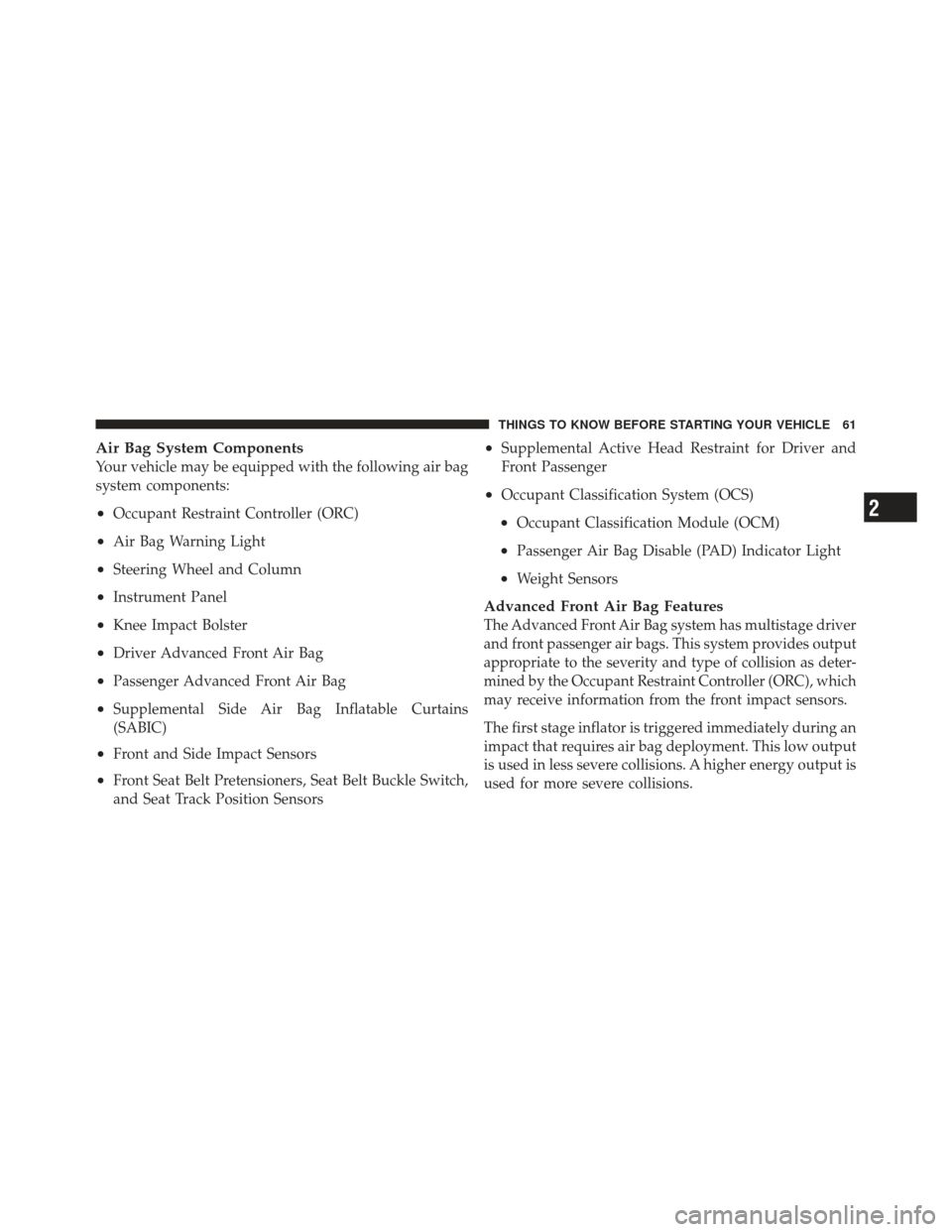
Air Bag System Components
Your vehicle may be equipped with the following air bag
system components:
•Occupant Restraint Controller (ORC)
•Air Bag Warning Light
•Steering Wheel and Column
•Instrument Panel
•Knee Impact Bolster
•Driver Advanced Front Air Bag
•Passenger Advanced Front Air Bag
•Supplemental Side Air Bag Inflatable Curtains
(SABIC)
•Front and Side Impact Sensors
•Front Seat Belt Pretensioners, Seat Belt Buckle Switch,
and Seat Track Position Sensors
•Supplemental Active Head Restraint for Driver and
Front Passenger
•Occupant Classification System (OCS)
•Occupant Classification Module (OCM)
•Passenger Air Bag Disable (PAD) Indicator Light
•Weight Sensors
Advanced Front Air Bag Features
The Advanced Front Air Bag system has multistage driver
and front passenger air bags. This system provides output
appropriate to the severity and type of collision as deter-
mined by the Occupant Restraint Controller (ORC), which
may receive information from the front impact sensors.
The first stage inflator is triggered immediately during an
impact that requires air bag deployment. This low output
is used in less severe collisions. A higher energy output is
used for more severe collisions.
2
THINGS TO KNOW BEFORE STARTING YOUR VEHICLE 61
Page 69 of 558

WARNING!
Ignoring the Air Bag Warning Light in your instru-
ment panel could mean you won’t have the air bags
to protect you in a collision. If the light does not come
on as a bulb check when the ignition is first turned
on, stays on after you start the vehicle, or if it comes
on as you drive, have an authorized dealer service the
air bag system immediately.
Occupant Classification System (OCS)
The OCS is part of a Federally regulated safety system
required for this vehicle. It is designed to turn off the
passenger Advanced Front Air Bag for an empty seat and
for occupants classified in a category other than an adult.
This could be a child, teenager, or even an adult.
NOTE:Children 12 years or younger should always
ride buckled up in a rear seat in an appropriate child
restraint.
•Occupant Classification Module (OCM)
The OCM is located beneath the front passenger seat. The
OCM classifies the occupant into categories based on the
measurements made by the seat weight sensors. The
OCM communicates with the ORC. The ORC uses the
occupant category to determine whether the passenger
Advanced Front Air Bag should be turned off. It also
determines the rate of air bag inflation during a collision.
•Weight Sensors
Your vehicle has four Weight Sensors located between the
seat and the floor pan. The weight sensors measure
applied weight and transfers that information to the
OCM.
•Passenger Air Bag Disable (PAD) Indicator Light
The PAD Indicator Light (an amber light located in the
center of the instrument panel) tells the driver and front
passenger when the passenger Advanced Front Air Bag is
turned off. The PAD Indicator light illuminates the words
2
THINGS TO KNOW BEFORE STARTING YOUR VEHICLE 67
Page 71 of 558
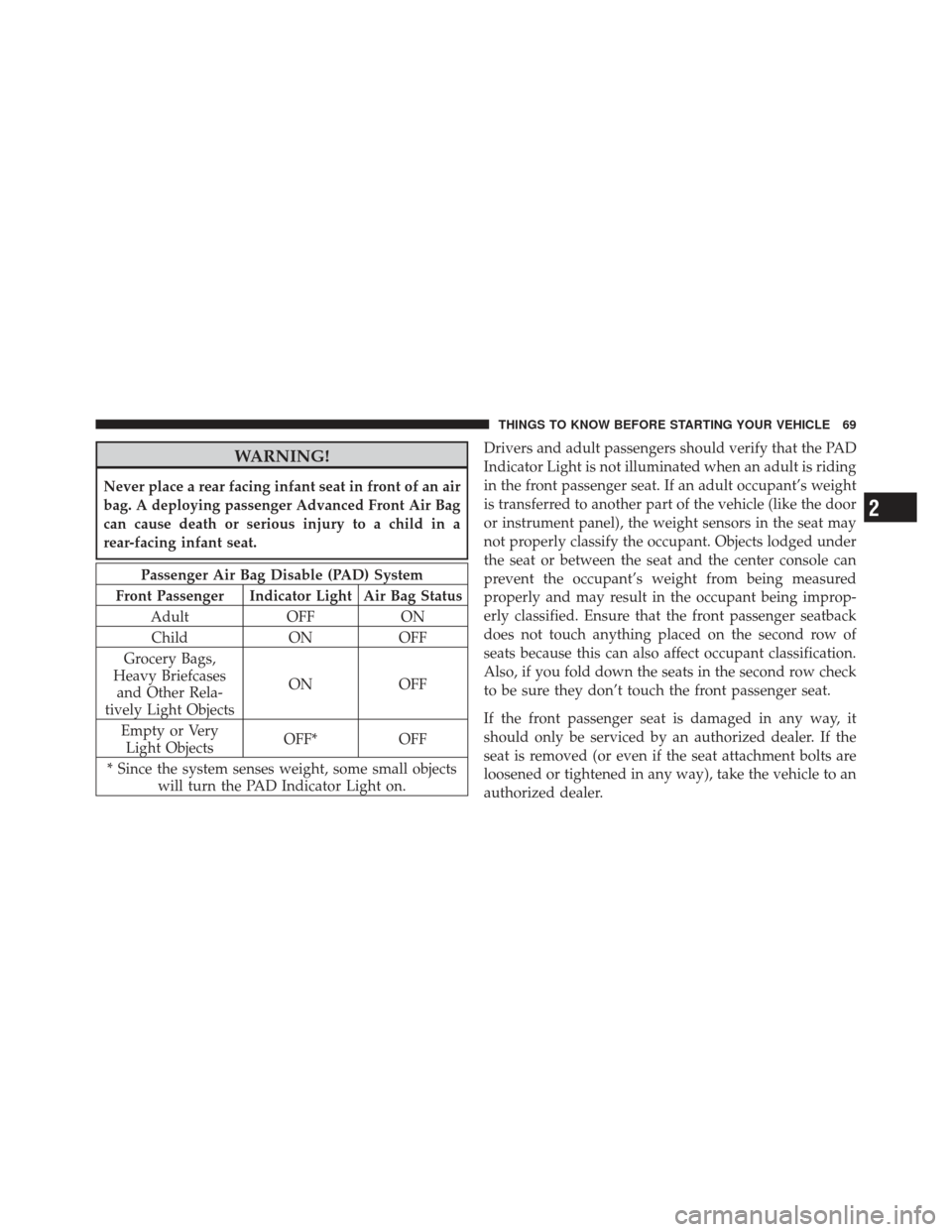
WARNING!
Never place a rear facing infant seat in front of an air
bag. A deploying passenger Advanced Front Air Bag
can cause death or serious injury to a child in a
rear-facing infant seat.
Passenger Air Bag Disable (PAD) System
Front Passenger Indicator Light Air Bag Status Adult OFFON
Child ONOFF
Grocery Bags,
Heavy Briefcases and Other Rela-
tively Light Objects ON
OFF
Empty or Very Light Objects OFF*
OFF
* Since the system senses weight, some small objects will turn the PAD Indicator Light on. Drivers and adult passengers should verify that the PAD
Indicator Light is not illuminated when an adult is riding
in the front passenger seat. If an adult occupant’s weight
is transferred to another part of the vehicle (like the door
or instrument panel), the weight sensors in the seat may
not properly classify the occupant. Objects lodged under
the seat or between the seat and the center console can
prevent the occupant’s weight from being measured
properly and may result in the occupant being improp-
erly classified. Ensure that the front passenger seatback
does not touch anything placed on the second row of
seats because this can also affect occupant classification.
Also, if you fold down the seats in the second row check
to be sure they don’t touch the front passenger seat.
If the front passenger seat is damaged in any way, it
should only be serviced by an authorized dealer. If the
seat is removed (or even if the seat attachment bolts are
loosened or tightened in any way), take the vehicle to an
authorized dealer.
2
THINGS TO KNOW BEFORE STARTING YOUR VEHICLE 69
Page 72 of 558

If there is a fault present in the air bag system, the Air Bag
Warning Light (a red light located in the center of the
instrument cluster directly in front of the driver) will be
turned on. This indicates that you should have an autho-
rized dealer service the system immediately. The Air Bag
Warning Light is turned on whenever there is a fault that
can affect the operation of the air bag system. If there is a
fault present in the PAD Indicator Light, the Air Bag
Warning Light will be illuminated to show that the
passenger Advanced Front Air Bag may be turned off
until the fault is cleared. If the Air Bag Warning Light is
illuminated, have an authorized dealer service the air bag
system immediately. If an object is lodged under the seat
and interferes with operation of the weight sensors, a
fault will occur which turns on both the PAD Indicator
Light and the Air Bag Warning Light. Once the lodged
object is removed, the fault will be automatically cleared
after a short period of time.Driver And Passenger Advanced Front Air Bag
Inflator Units
TheDriver And Passenger Advanced Front Air Bag
Inflator Units are located in the center of the steering
wheel and on the right side of the instrument panel.
When the ORC detects a collision requiring the Ad-
vanced Front Air Bags, it signals the inflator units. A large
quantity of non-toxic gas is generated to inflate the
Advanced Front Air Bags. Different air bag inflation rates
are possible based on collision severity and type. The
steering wheel hub trim cover and the upper right side of
the instrument panel separate and fold out of the way as
the air bags inflate to their full size. The air bags fully
inflate in about 50 to 70 milliseconds. This is about half of
the time it takes to blink your eyes. The air bags then
quickly deflate while helping to restrain the driver and
front passenger.
70 THINGS TO KNOW BEFORE STARTING YOUR VEHICLE
Page 81 of 558
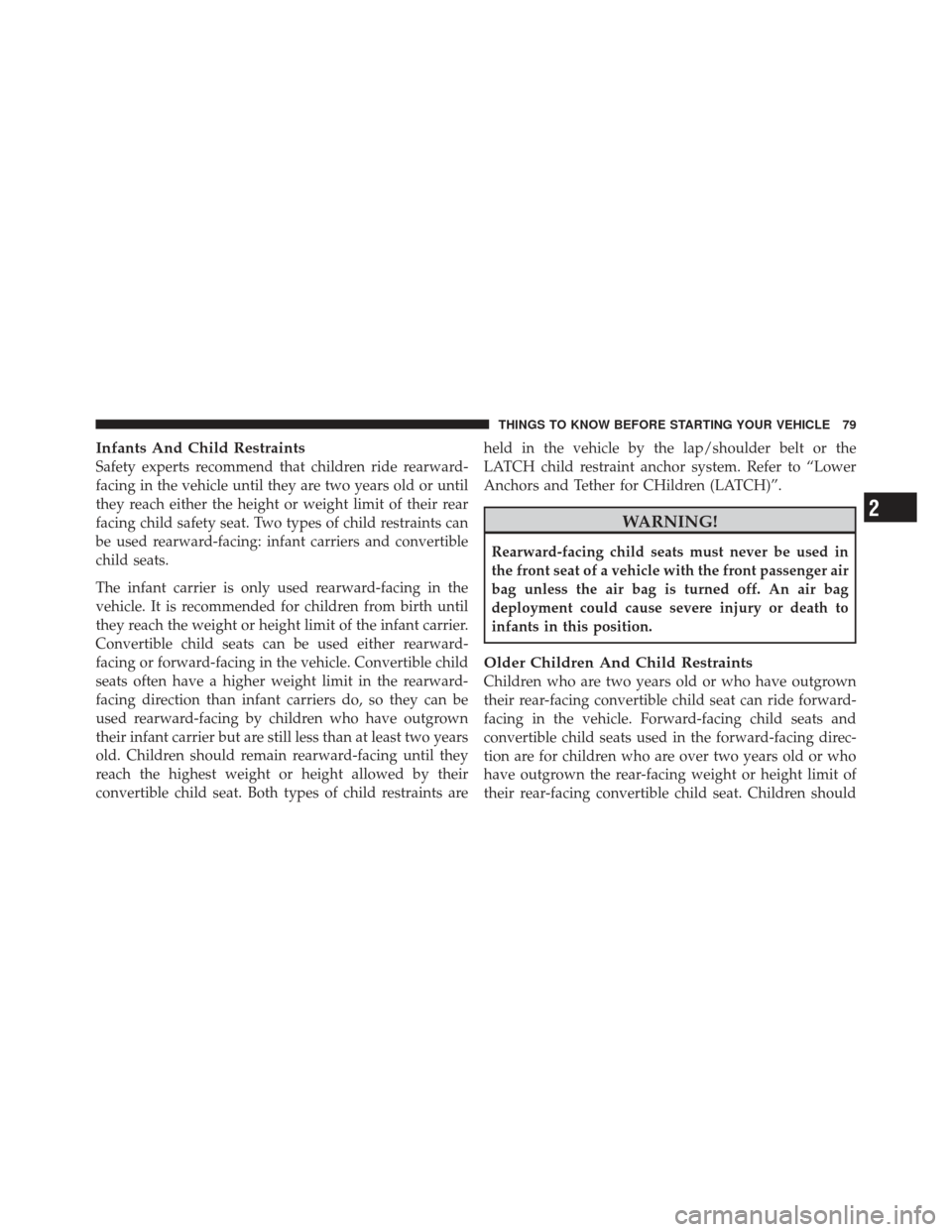
Infants And Child Restraints
Safety experts recommend that children ride rearward-
facing in the vehicle until they are two years old or until
they reach either the height or weight limit of their rear
facing child safety seat. Two types of child restraints can
be used rearward-facing: infant carriers and convertible
child seats.
The infant carrier is only used rearward-facing in the
vehicle. It is recommended for children from birth until
they reach the weight or height limit of the infant carrier.
Convertible child seats can be used either rearward-
facing or forward-facing in the vehicle. Convertible child
seats often have a higher weight limit in the rearward-
facing direction than infant carriers do, so they can be
used rearward-facing by children who have outgrown
their infant carrier but are still less than at least two years
old. Children should remain rearward-facing until they
reach the highest weight or height allowed by their
convertible child seat. Both types of child restraints areheld in the vehicle by the lap/shoulder belt or the
LATCH child restraint anchor system. Refer to “Lower
Anchors and Tether for CHildren (LATCH)”.
WARNING!
Rearward-facing child seats must never be used in
the front seat of a vehicle with the front passenger air
bag unless the air bag is turned off. An air bag
deployment could cause severe injury or death to
infants in this position.
Older Children And Child Restraints
Children who are two years old or who have outgrown
their rear-facing convertible child seat can ride forward-
facing in the vehicle. Forward-facing child seats and
convertible child seats used in the forward-facing direc-
tion are for children who are over two years old or who
have outgrown the rear-facing weight or height limit of
their rear-facing convertible child seat. Children should
2
THINGS TO KNOW BEFORE STARTING YOUR VEHICLE 79
Page 82 of 558
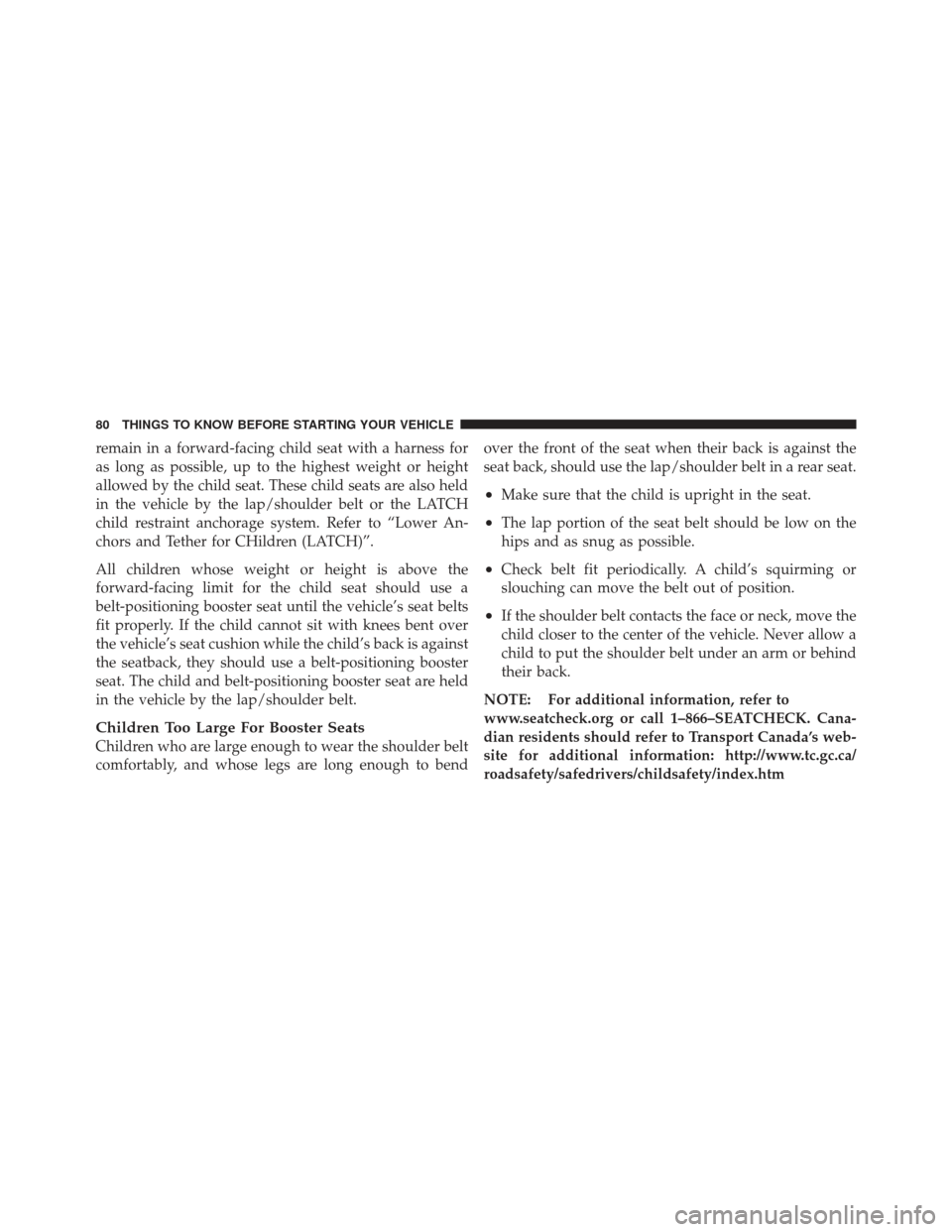
remain in a forward-facing child seat with a harness for
as long as possible, up to the highest weight or height
allowed by the child seat. These child seats are also held
in the vehicle by the lap/shoulder belt or the LATCH
child restraint anchorage system. Refer to “Lower An-
chors and Tether for CHildren (LATCH)”.
All children whose weight or height is above the
forward-facing limit for the child seat should use a
belt-positioning booster seat until the vehicle’s seat belts
fit properly. If the child cannot sit with knees bent over
the vehicle’s seat cushion while the child’s back is against
the seatback, they should use a belt-positioning booster
seat. The child and belt-positioning booster seat are held
in the vehicle by the lap/shoulder belt.
Children Too Large For Booster Seats
Children who are large enough to wear the shoulder belt
comfortably, and whose legs are long enough to bendover the front of the seat when their back is against the
seat back, should use the lap/shoulder belt in a rear seat.
•Make sure that the child is upright in the seat.
•The lap portion of the seat belt should be low on the
hips and as snug as possible.
•Check belt fit periodically. A child’s squirming or
slouching can move the belt out of position.
•If the shoulder belt contacts the face or neck, move the
child closer to the center of the vehicle. Never allow a
child to put the shoulder belt under an arm or behind
their back.
NOTE: For additional information, refer to
www.seatcheck.org or call 1–866–SEATCHECK. Cana-
dian residents should refer to Transport Canada’s web-
site for additional information: http://www.tc.gc.ca/
roadsafety/safedrivers/childsafety/index.htm
80 THINGS TO KNOW BEFORE STARTING YOUR VEHICLE
Page 83 of 558
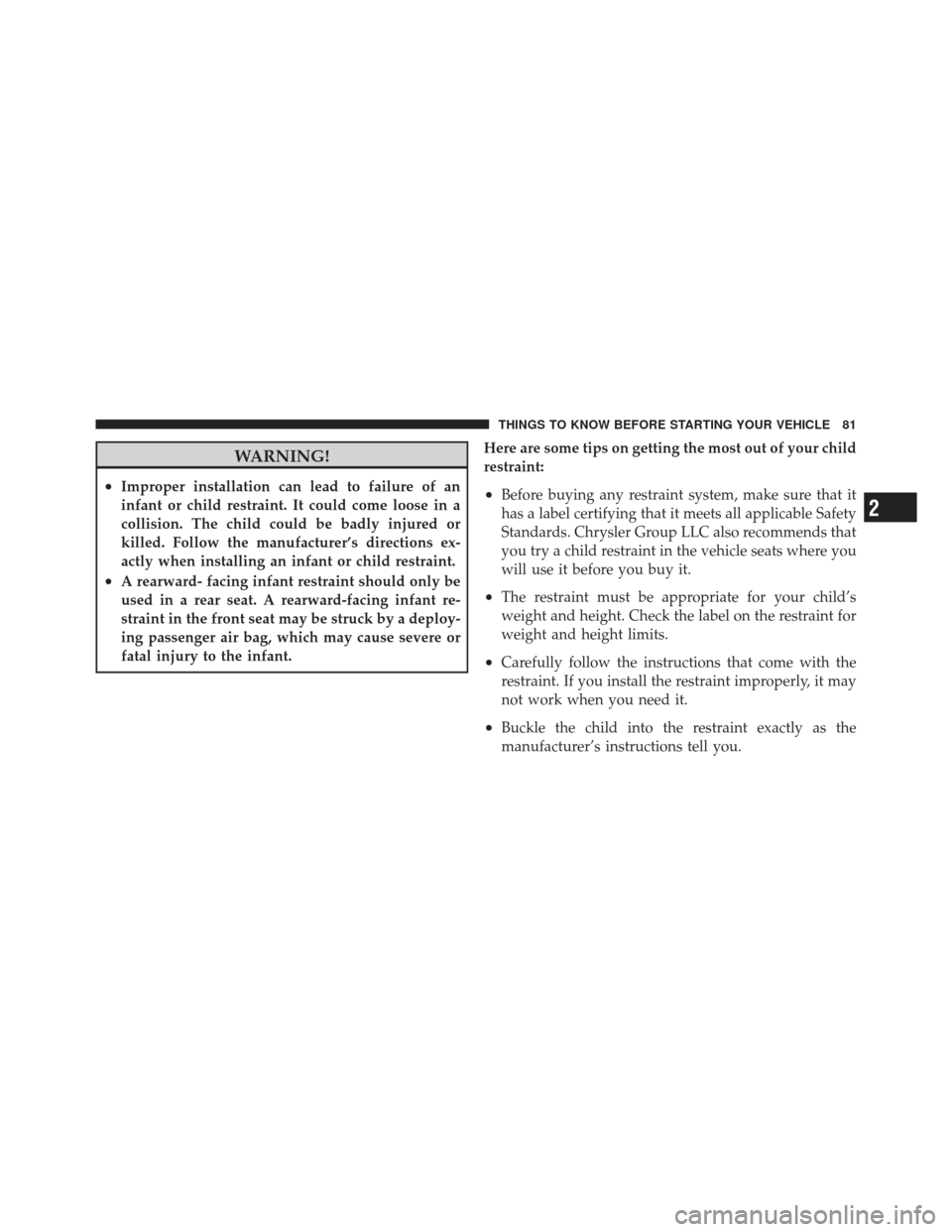
WARNING!
•Improper installation can lead to failure of an
infant or child restraint. It could come loose in a
collision. The child could be badly injured or
killed. Follow the manufacturer’s directions ex-
actly when installing an infant or child restraint.
•A rearward- facing infant restraint should only be
used in a rear seat. A rearward-facing infant re-
straint in the front seat may be struck by a deploy-
ing passenger air bag, which may cause severe or
fatal injury to the infant.Here are some tips on getting the most out of your child
restraint:
•Before buying any restraint system, make sure that it
has a label certifying that it meets all applicable Safety
Standards. Chrysler Group LLC also recommends that
you try a child restraint in the vehicle seats where you
will use it before you buy it.
•The restraint must be appropriate for your child’s
weight and height. Check the label on the restraint for
weight and height limits.
•Carefully follow the instructions that come with the
restraint. If you install the restraint improperly, it may
not work when you need it.
•Buckle the child into the restraint exactly as the
manufacturer’s instructions tell you.
2
THINGS TO KNOW BEFORE STARTING YOUR VEHICLE 81
Page 213 of 558
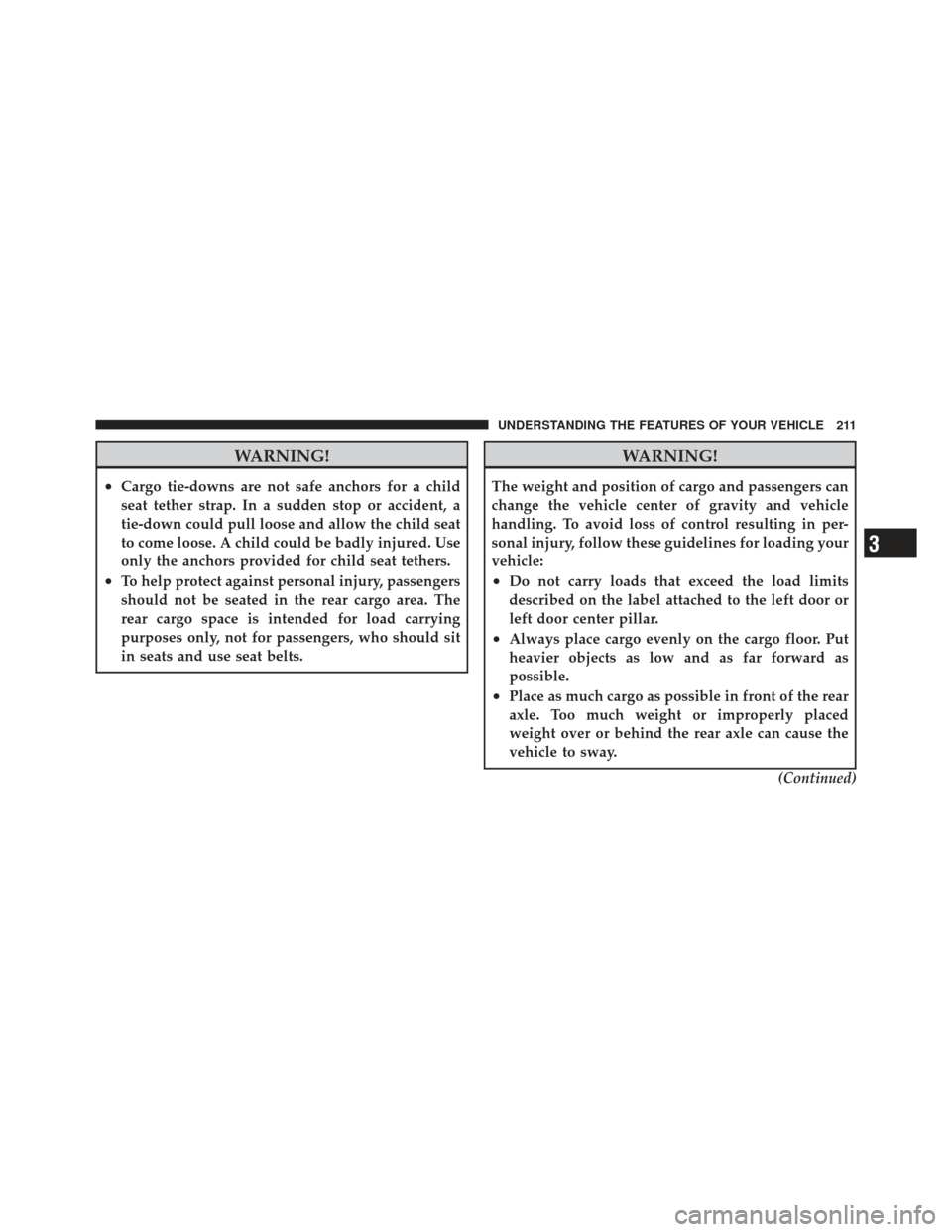
WARNING!
•Cargo tie-downs are not safe anchors for a child
seat tether strap. In a sudden stop or accident, a
tie-down could pull loose and allow the child seat
to come loose. A child could be badly injured. Use
only the anchors provided for child seat tethers.
•To help protect against personal injury, passengers
should not be seated in the rear cargo area. The
rear cargo space is intended for load carrying
purposes only, not for passengers, who should sit
in seats and use seat belts.
WARNING!
The weight and position of cargo and passengers can
change the vehicle center of gravity and vehicle
handling. To avoid loss of control resulting in per-
sonal injury, follow these guidelines for loading your
vehicle:
•Do not carry loads that exceed the load limits
described on the label attached to the left door or
left door center pillar.
•Always place cargo evenly on the cargo floor. Put
heavier objects as low and as far forward as
possible.
•Place as much cargo as possible in front of the rear
axle. Too much weight or improperly placed
weight over or behind the rear axle can cause the
vehicle to sway.(Continued)
3
UNDERSTANDING THE FEATURES OF YOUR VEHICLE 211